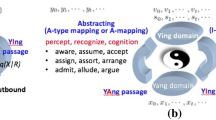Abstract
Causal reasoning (known also as abduction) is a hard task that cognitive agents perform reliably and quickly. A particular class of causal reasoning that raises several difficulties is the cancellation class. Cancellation occurs when a set of causes (hypotheses) cancel each other's explanation with respect to a given effect (observation). For example, a cloudy sky may suggest a rainy weather; whereas a shiny sky may suggest the absence of rain. In the current paper, we extend a recent neural model to handle cancellation interactions. We conduct a sensitivity analysis of this proposal on ad hoc problems put at extreme cases. Finally, we test the model on a large database and propose objective criteria to quantitatively evaluate its performance. Simulation results are very satisfactory and should encourage research.
Similar content being viewed by others
References
B. Ayeb, S. Wang, and J. Ge, “A unified model for abduction based reasoning,” IEEE Transactions on Systems, Man and Cybernetics, vol. 28, no.4, pp. 408–425, 1998.
Y. Peng and J.A. Reggia, “A connectionist model for diagnostic problem solving,” IEEE Transactions on Systems, Man and Cybernetics, vol. 19, pp. 285–289, 1989.
K. Eshghi, “Abductive planning with event calculus,” in Proceedings of the 4th International Conference and Symposium on Logic Programming, 1988, pp. 563–579.
E. Charniak, “Connectionism and explanation,” in Theoretical Issues in Natural Language Processing, Las Cruses NM, USA, 1987, pp. TINLAP–3.
P. Thagard, “Explanatory coherence,” Behavioral and Brain Sciences, vol. 12, pp. 435–502, 1989.
O. Fischer, A. Goel, J. Svirbely, and J. Smith, “The role of essential explanations in abduction,” Artificial Intelligence in Medicine, vol. 3, pp. 181–191, 1991.
A. Goel, J. Josephson, O. Fischer, and P. Sadayappan, “Practical abduction: Characterization, decomposition and distribution,” Journal of Experimental and Theoretical Artificial Intelligence, vol. 7, pp. 429–450, 1995.
J.R. Josephson, B. Chandrasekaran, and J. Smith, “A mechanism for forming composite explanatory hypotheses,” IEEE Transactions on Systems, Man and Cybernetics, Special Issue on Causal and Strategic Aspects of Diagnostic Reasoning, vol. SMC-17, no.3, pp. 445–454, 1987.
A. Goel, J. Ramanujam, and P. Sadayappan, ”Towards a ‘neural’ architecture for abductive reasoning,” in Proceedings of the 2nd International Conference on Neural Networks, 1988, pp. 681–688.
T. Bylander, D. Allemang, M.C. Tanner, and J.R. Josephon, “The computational complexity of abduction,” Artificial Intelligence, vol. 49, pp. 25–60, 1991.
C. Peterson and J.R. Anderson, “Neural networks and NP-complete optimization problems: A performance study on the graph bisection problem,” Complex Systems, vol. 2, pp. 59–89, 1988.
B. Ayeb, P. Marquis, and M. Rusinowitch, “Preferring diagnoses by abduction,” IEEE Transactions on Systems, Man and Cybernetics, vol. 23, pp. 792–808, 1993.
D. Poole, “Logical programming, abduction and probabilities: A top-down algorithm for computing prior and posterior probabilities,” New Generation Computing, vol. 11, nos.3/4, pp. 377–400, 1993.
J. Pearl, “Distributed revision of composite beliefs,” Artificial Intelligence, vol. 33, pp. 173–215, 1987.
S. Grossberg, “Nonlinear neural networks: Principles, mechanisms, and architectures,” Neural Networks, vol. 1, pp. 17–61, 1988.
S. Amari and M. Arbib, Competition and Cooperation in Neural Nets, Springer-Verlag: New York, NY, 1982.
D. Rumelhart and D. Zipser, “Feature discovery by competitive learning,” Cognitive Science, vol. 9, pp. 75–112, 1985.
T. Brown, E. Kairiss, and C. Keenan, “Hebbian synapses: Biophysical mechanisms and algorithms,” Annual Review of Neuroscience, vol. 13, pp. 475–511, 1990.
T. Kohonen, G. Barna, and R. Chrisley, “Statistical pattern recognition with neural networks: Benchmarking studies,” in Proceedings of the International Conference on Neural Networks, vol. 1, San Dieg, CA, USA, 1988, pp. 61–68.
C. Eliasmith and P. Thagard, “Waves, particles, and explanatory coherence,” British Journal for the Philosophy of Science, vol. 48, pp. 1–19, 1997.
Y. Peng and J.A. Reggia, “A probabilistic causal model for diagnostic problem solving (two parts),” IEEE Transactions on Systems, Man and Cybernetics, vol. 17, pp. 146–162/395–406, 1987.
J.J. Hopfield and D.W. Tank, “‘Neural’ computation of decisions in optimization problems,” Biological Cybernetics, vol. 52, pp. 141–152, 1985.
J. Wald, M. Farah, M. Tagamets, and J. Reggia, “Generating plausible diagnosis with self-processing causal networks,” Journal of Experimental and Theoretical Artificial Intelligence, vol. 2, pp. 91–112, 1989.
Author information
Authors and Affiliations
Rights and permissions
About this article
Cite this article
Romdhane, L.B., Ayeb, B. & Wang, S. A Distributed Artificial Network Solving Complex and Multiple Causal Associations. Applied Intelligence 19, 189–207 (2003). https://doi.org/10.1023/A:1026010008129
Issue Date:
DOI: https://doi.org/10.1023/A:1026010008129




